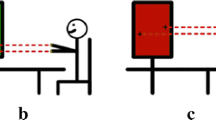Abstract
Circa1895, James M. Baldwin introduced a powerful view regarding Darwinian Evolution. Baldwin suggested that behavioral flexibility could play a role in amplifying natural selection because this ability enables individuals to modify the environment of natural selection affecting the fate of future generations. In this view, behavior can affect evolution but, and this is crucial, without claiming that responses to environmental demands acquired during one’s lifetime could be passed directly to one’s offspring. In the present paper, we want to use this view as a guiding metaphor to cast light on understanding how students and teachers can utilize the environment of digital technologies to scaffold their activities. We present examples of activities from geometry and algebra in high school settings that illustrate the potential role that certain technologies can have in transforming classroom interaction and work.









Similar content being viewed by others
References
Baldwin, M. (1896). A new factor of evolution. American Naturalist, 30, 441–451, 536–553.
Bateson, G. (1972). Steps to an ecology of mind. New York: Ballantine.
Cole, M. (1996). Cultural psychology: A once and future discipline. Cambridge: Harvard University Press.
Deacon, T. (1997). The symbolic species: The co-evolution of language and the human brain. New York: W.W. Norton & Company.
Donald, M. (1993). Origins of the modern mind: Three stages in the evolution of culture and cognition. Cambridge: Harvard University Press.
Donald, M. (2001). A mind so rare: The evolution of human consciousness. New York: W. W. Norton & Company.
Duval, R. (2006). A cognitive analysis of problems of comprehension in a learning of mathematics. Educational Studies in Mathematics, 61(1/2), 103–131.
Geertz, C. (1973). The interpretation of cultures. New York: Basic Books.
Hegedus, S., Kaput, J. J., Dalton, S., Moniz, R., & Roschelle, J. (2007). SimCalc classroom connectivity project 2: Understanding classroom interactions among diverse connected classrooms technology—Overview of the present finding of a 4-year study (2004–2008). Technical Report 1:1. Dartmouth, MA: University of Massachusetts Dartmouth, James J. Kaput Center for Research and Innovation in Mathematics Education.
Hegedus, S., & Penuel, W. (2008). Studying new forms of participation and classroom identity in mathematics classrooms with integrated communication and representational infrastructures. Special issue of Educational Studies in Mathematics: Democratizing Access to Mathematics Through Technology—Issues of Design and Implementation, 68(2), 171–183.
Hoffmeyer, J., & Krull, K. (2003). Baldwin and biosemiotics: What intelligence is for. In B. Weber & D. Depew (Eds.), Evolution and learning: The Baldwin effect reconsidered (pp. 253–271). Cambridge: MIT Press.
Hutchins, E. (1996). Cognition in the wild. Cambridge: MIT Press.
Kline, M. (1962). Mathematics: A cultural approach. Reading: Addison-Wesley.
Kline, M. (1980). Mathematics: The loss of certainty. New York: Oxford University Press.
Moreno-Armella, L., Hegedus, S., & Kaput, J. (2008). From static to dynamic mathematics: Historical and representational perspectives. Special issue of Educational Studies in Mathematics: Democratizing Access to Mathematics Through Technology—Issues of Design and Implementation, 68(2), 99–111.
Rogoff, B. (1990). Apprenticeship in thinking. New York: Oxford University Press.
Schmandt-Besserat, D. (1996). How writing came about. Austin: University of Texas Press.
Valsiner, J., & van der Veer, R. (2005). On the social nature of human cognition. In H. Daniels (Ed.), An introduction to Vygotsky (2nd ed., pp. 81–100). London: Routledge.
Wartofsky, M. (1979). Models, representation and the scientific understanding. Dordrecht: Reidel.
Wertsch, J. (1985). Vygotsky and the social formation of mind. Cambridge: Harvard University Press.
Author information
Authors and Affiliations
Corresponding author
Additional information
This work is based upon work supported by the National Science Foundation under grant REC-0337710 and the Institute of Education Sciences at the US Department of Education under grant R305B070430. Any opinions, findings, and conclusions or recommendations expressed in this material are those of the author(s) and do not necessarily reflect the views of these agencies.
Rights and permissions
About this article
Cite this article
Moreno-Armella, L., Hegedus, S.J. Co-action with digital technologies. ZDM Mathematics Education 41, 505–519 (2009). https://doi.org/10.1007/s11858-009-0200-x
Accepted:
Published:
Issue Date:
DOI: https://doi.org/10.1007/s11858-009-0200-x




